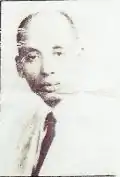Haji Farah Ali Omar
Haji Farah Ali Omar (Somali: Xaaji Faarax Cali Cumar, Arabic: الحاج فرح علي عمر) (1907 – unknown) was born in the town of Hobyo, situated in the Mudug region of Somalia, and was a Somali politician. He was a senior official in the government of the Trust Territory of Somalia and later served as Minister of Economic Affairs in Somalia's post-independence civilian administration.[1]
Haji Farah Ali Omar الحاج فرح علي عمر | |
|---|---|
 | |
| Minister for Economic Affairs of Somalia | |
| In office 1956–1960 | |
| Personal details | |
| Born | 1907 Hobyo, Somalia |
Biography
Omar was born in 1907 in the town of Jamaame, situated in the Lower Juba region of Somalia.[2] Hon. Haji Farah was born in Jamaame in 1907 to parents from the middle region (Mudug). Farah spent his early years with his mother and after she passed away he lived with his father and stepmother briefly. After his mother's death, Farah failed to cope with his emotions and ran away from his father's home due to hostility from his stepmother. Farah started doing odd jobs in old town Mogadishu at the age of thirteen. He earned little but it was enough to pay for his studies. Farah succeeded in his studies and eventually he got a scholarship to Al-Azhar university in Cairo, Egypt.
Political career
Omar served as a Party Representative in the Territorial Council from 1952 to 1956. He was later appointed Minister for Economic Affairs in the Trust Territory of Somalia (1956) and the post-independence civilian government led by President Aden Abdullah Osman Daar. As a member of the government both before and after Somalia's independence, Omar was a member of various missions to the United States and to the United Nations.[3]
References
- "De-classified Documents: Foreign Relations of the United States 1964-1968, Volume XXIV Africa:346. Memorandum From the Under Secretary of State (Katzenbach) to President Johnson: March 12, 1968". Somali Watch (source: US Department of State, Washington). November 29, 200. Archived from the original on 20 November 2010. Retrieved 1 November 2010.
- http://www.banadir.com/history.htm
- "NEWS". Banadir.com. Retrieved 1 November 2010.